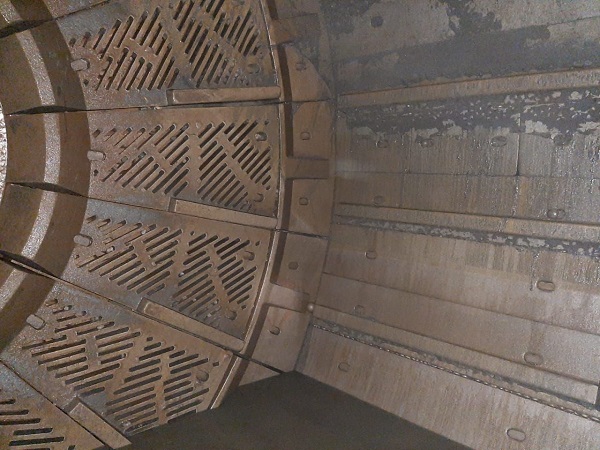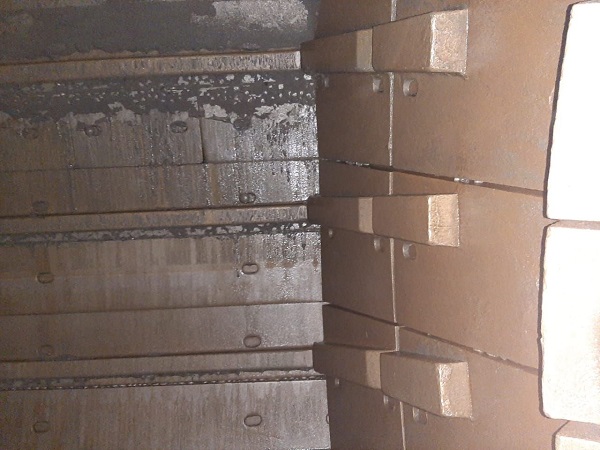H&G’s Chrome Moly SAG Mill Liners Running Very Well in MZS5518 SAG Mill in Taksimo, Russia
H&G has delivered 42 tons Chrome Moly SAG mill liners for our gold mining clients located in Tasimoko in Russia, now the clients has successfully installed these SAG mil liners and running the SAG mill normally. Previous the client is using high manganese steel mill liners Mn13Cr2, but the wear life time is very short, our Chrome Moly SAG mill liners will has 30% longer lifetime than the manganese steel mill liners. Now the MZS5518 SAG mill is running very well according to the feedback from our client.
Our SAG Mill Liner are widely used in the grinding stage for mining industry, cement industry, thermal power plant, paper-making and chemical industry etc.
Semi-autogenous mills or SAG mills, as they are often called, can accomplish the same size reduction work as two or three stages of crushing and screening. Often used in grinding at modern mineral processing plants, SAG mills reduce the material directly to the desired final size or prepare it for the following grinding stages.
Lower lifetime cost
The range of mill sizes and versatile applications allow SAG milling to be accomplished with fewer lines than conventional set-ups. This, in turn, contributes to lower capital and maintenance costs for a SAG mill circuit.
Versatile applications
SAG milling extends itself to many applications due to the range of mill sizes available. They can accomplish the same size reduction work as two or three stages of crushing and screening, a rod mill and some or all of the work done by a ball mill.
SAG mills are also an optimum solution for wet grinding since crushing and screening in these cases can be difficult, if not impossible.
Efficiency through automatic operation
Metso’s process engineers will assist you in creating an efficient software-driven process, from circuit design to start-up and optimization, to ensure you get your desired grinding results.
Through automatic operation it is possible to save power, grinding media, and linear wear, while increasing capacity.
With the shortage of high-quality iron ore and other resources in China, a large number of low-grade materials begin to enter the beneficiation process, which reduces the grinding efficiency of the ball mill, and the liner is the most important consumption part of the mill. According to statistical data, the loss of mill liner in China is about 0.2kg/t, while that of western developed countries (such as Canada, the United States, etc.) is only 0.05kg/t. It can be seen that there is still a lot of room to improve the quality of mining mill liners in China.
Wear principle of mill liners
When the ball mill is working, animal feed, grinding medium, and water enter the cylinder body through the feeding device, and the main motor drives the cylinder to rotate. The material is impacted by the grinding medium (steel ball) inside the cylinder, and the grinding between the grinding medium and the grinding medium and the lining plate completes the grinding process. In this process, the liner of the ball mill is in direct contact with the material and grinding medium, and the medium and material form grinding and impact on the liner, which is the main reason for liner wear.
Metal mining mill liners
- High chromium cast iron mining mill liners. High chromium cast iron is made by adding a small amount of Cu, Ti, V, B, and other elements on the basis of original C, Cr, Si, Mn, Mo, and other metal elements. Its hardness is HRC ≥ 56, which has good wear resistance and is widely used. Its main defect is that it is easy to deform at high temperatures when it is used as the liner of the ball mill. In addition, the existence of a large number of carbides in the material makes it easy to crack under the impact of material and medium. In recent years, a lot of research and experiments have been carried out on high chromium cast iron in our country. Adding an appropriate amount of W, B, Ti, V, re, etc., can reduce the use of Mo, Cu, Ni, etc., which can improve the properties of high chromium cast iron and reduce the production cost. In recent years, vanadium titanium high chromium cast iron with rare earth elements V and Ti has been used to replace Mo, Cu, and other expensive materials with a small number of rare earth elements V and Ti. The hardness of the material is HRC = 62.6, and the toughness has been greatly improved. The properties of the material are much higher than that of the traditional high chromium cast iron.
- Alloy cast steel series mining mill liners. In recent years, wear-resistant alloy liner was firstly approved by import, and it is widely used in small and medium-sized ball mills and two-stage mills with weak impact force. Among them, high toughness heat resistant and wear-resistant cast steel, high wear-resistant bainite cast steel, high boron cast steel, chromium-molybdenum cast steel, medium chromium alloy wear-resistant cast steel, etc.High wear resistance high chromium cast steel is made of high chromium cast iron by reducing the content of C, Mo, Ni, Mn, Cu, and adding a small number of rare earth elements. The process of “quenching + tempering” heat treatment has greatly improved its toughness and wear resistance.The high wear-resistant bainitic cast steel is made of Mn, Cr, Si as the main alloy materials, a small amount of Mo, Ni, Ti, and so on. It is made by normalizing and tempering the heat-treatment process. Its hardness is HRC = 49 and its impact toughness is outstanding. Its wear resistance is about 2 times of that of high carbon cast iron liner, which is suitable for manufacturing mill liner.High boron cast steel is made of low carbon steel with 1.2% – 3.0% B and a small amount of Mn, Cr, Ti, V and re, etc. and is made by “quenching and tempering” heat-treatment process. Its hardness HRC = 58, it is mainly used in the grinding operation area with small impact force, and its wear resistance is about twice as high manganese steel, and it has the characteristics of high reliability and low cost.Chromium-molybdenum cast steel is made by oil quenching and tempering heat-treatment process. Because of its high hardness (HRC = 56), high strength, good toughness, good wear resistance, good bending and tension resistance, and long service life (3 times as high as that of ordinary high manganese steel), it has been widely recognized in China and started to develop and produce.
Rubber mining mill liners
- Rubber mill liners. Rubber ball mill liner was recognized abroad in the 1950s. It was mainly used in medium and small mills. Now it has been widely used in various types of ball mills, and its working temperature is generally less than or equal to 70 ℃. Compared with the metal mill liners, rubber mill liners has the following advantages: 1) wear resistance, corrosion resistance, long service life, and other advantages; 2) the self-weight of a rubber mill liner is only 1 / 7 of the same volume metal mill liners, which can greatly reduce the mechanical and electrical loss of ball mill and reduce the labor intensity of installation and maintenance. 3) reduce the working noise of the ball mill. However, a large number of rubber liners used in ball mills will reduce the processing capacity per unit time and increase the unit energy consumption. Therefore, rubber ball mill liners are mainly used in the end cover of ball mills.
- Rubber metal composite mill liners. The rubber-metal composite liner is made of alloy steel and rubber by cross molding. Alloy material is used in the direct contact part with materials and grinding medium, and low-cost common steel is used at the fixed part of liner and cylinder, and rubber is used in the middle part of both, which can reduce the weight of lining plate and reduce vibration. This kind of lining plate not only ensures the work efficiency of the ball mill but also reduces the weight of the mill liners, reduces the energy consumption per unit output, and improves the service life of the mill liners.
Magnetic mining mill liner
- Working principle of the magnetic liner. The magnetic lining plate is made of magnetic materials and installed on the inner wall of the ball mill. In the work, the magnetic lining plate adsorbs a certain thickness of material on its surface as a protective layer, which can greatly reduce the grinding effect of media and materials on the lining plate, and improve the service life of the lining plate.The practice has proved that the service life of the magnetic lining plate is 4-8 times longer than that of the ordinary steel lining plate. Rubber magnetic liner is widely used in foreign countries, but steel magnetic liner is widely used in China due to cost limitations.
- Application of magnetic liner in magnetic mine. The magnetic susceptibility of domestic large iron ore is 6300-12000m3 / kg, which is easy to form adsorption layer under the action of the magnetic liner, which is conducive to the popularization and application of magnetic liner. At present, magnetic liners have been widely used in the second stage mills of Shougang, Angang, and Baotou Steel.
The results
According to the different types of mines and the number of grinding sections, selecting the appropriate mill liner can improve work efficiency, reduce the energy consumption per unit output and increase the service life of the liner. In a section of ball mill with a large impact force of materials and abrasives, the liner made of high manganese alloy steel with strong impact resistance can be used for the cylinder, and rubber or rubber alloy composite liner can be used for the end cover; the magnetic liner can be used for the large two-stage mill in magnetic mines; the wear-resistant alloy cast steel lining plate and end cover can be used for the first section of medium and small-sized mills Rubber lining plate is used; high chromium cast iron mill liners or rubber mill liners can be used for the second stage.
@Nick Sun [email protected]
Post time: Jul-24-2020


